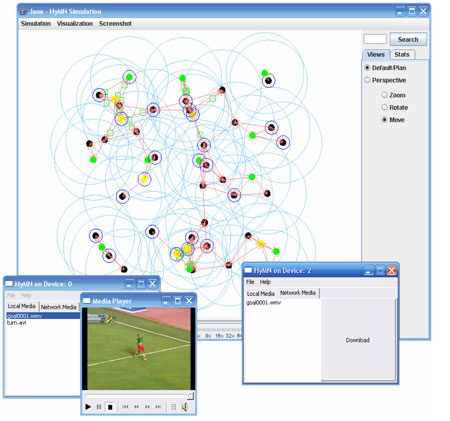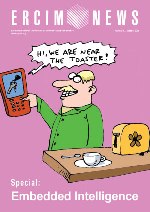by Steffen Rothkugel, Matthias R. Brust and Adrian Andronache
The concept of self-organisation already exists in the realm of ad-hoc networks. The inherent limitations of pure ad-hoc networks can be overcome by introducing uplinks to the Internet backbone. Extending the principles of self-organisation by transparently including those additional network links is the focus of the HyWercs project. HyMN, in turn, is a system aimed at fostering user experience by employing these concepts in the domain of multimedia content distribution.
Ad-hoc networks emphasise flexibility and survivability of the whole system. However, centralised approaches, for example for group management and information provisioning, do not work well in such settings. Moreover, due to frequent topology changes, connectivity of devices cannot be generally guaranteed. In particular, this makes it hard to disseminate information in a reliable way. We overcome these limitations inherent to pure ad-hoc networks by (a) establishing local groups of communicating devices in a self-organising manner and (b) introducing dedicated uplinks to a backbone infrastructure. Such uplinks are used for accessing resources available on the Internet. Additionally, they are employed to directly interconnect distant devices, either within a single partition and particularly also across different partitions. In practice, uplinks are realised for instance using cellular networks, satellites, or via Wi-Fi hotspots. Consequently, ad-hoc networks with devices that provide uplinks are called hybrid wireless networks throughout this paper.
One main goal of the HyWercs project is to develop a middleware that enables mobile devices to organise themselves in order to optimise the data access and provisioning process. The devices running the middleware keep track of the users interests, which can be single data items or topics that comprise several data items. Devices sharing common interests will join interest groups. Whenever there is the need to retrieve information from a backbone network - like the Internet - or to establish a communication link to a device in another network partition, uplinks are employed. The mobile devices elect a particular member of the interest group, a so-called injection point, which maintains the uplinks.
As one proof of concept, the HyMN system (Hybrid Multimedia Network) has been implemented prototypically on top of the JANE1 simulation environment. JANE is designed to support application and protocol design in the realm of ad-hoc networks. One distinct feature of JANE is that applications can be executed on top of simulated devices (see figure) as well as in so-called platform mode on real hardware.
HyMN is designed for users interested in live multimedia news, for example from certain sports events. Mobile devices of football fans, for instance, create an interest group in a local ad-hoc network partition. Multiples of such groups co-exist, such as football fans in pubs, those watching another match, traveling fans and more. In each of these cases, a considerable number of people have a shared interest and might join forces in a local setting.
The devices in the ad-hoc network running HyMN organise themselves in clusters, where the clusterheads act as injection points. For each group, interest in certain football matches is registered with the injection point. The injection point maintains an uplink to the backbone network in order to receive multimedia news related to the interests of the ad-hoc members. Thus, the football fans will receive injected information such as small videos, pictures or text messages each time something interesting is happening during the match. The multimedia files received remain stored on the mobile devices and will be provided to further devices joining the interest group later on.
In order to optimise the injection process, the backbone multimedia files are split into chunks. These chunks are injected concurrently to different injection points within a single ad-hoc network partition. Thus, the bandwidth for injecting data into a single partition is increased and the files reach the ad-hoc network faster. After reaching the network, the chunks are exchanged among the interested devices until all devices receive the complete file.

To realise the architecture presented, we focus on mobile devices establishing clusters in a self-organising way. For this, we have developed a clustering algorithm - namely WACA - that employs a heuristic weight function. The WACA algorithm (Weighted Application aware Clustering Algorithm) is designed to build an ad-hoc network topology that fits the needs of the application running on top of it. To achieve this, several parameters can be set in the weight function. The HyMN application focuses on multimedia content distribution from a backbone network to ad-hoc networks. To optimise this process, parameters like signal strength to the backbone network, long battery lifetime, dissemination degree and clustering coefficient are used for clusterhead election.
On-going research focuses on investigating how the mobile devices deal with different mobility scenarios. The HyMN system will be further developed and a middleware for wireless hybrid network devices will be developed from it.
Link:
http://mocca.uni.lu
http://syssoft.uni-trier.de/jane
Please contact:
Steffen Rothkugel, University of Luxembourg
Tel: +352 466644 5259
E-mail: steffen.rothkugel![]() uni.lu
uni.lu










